Squeeze Play
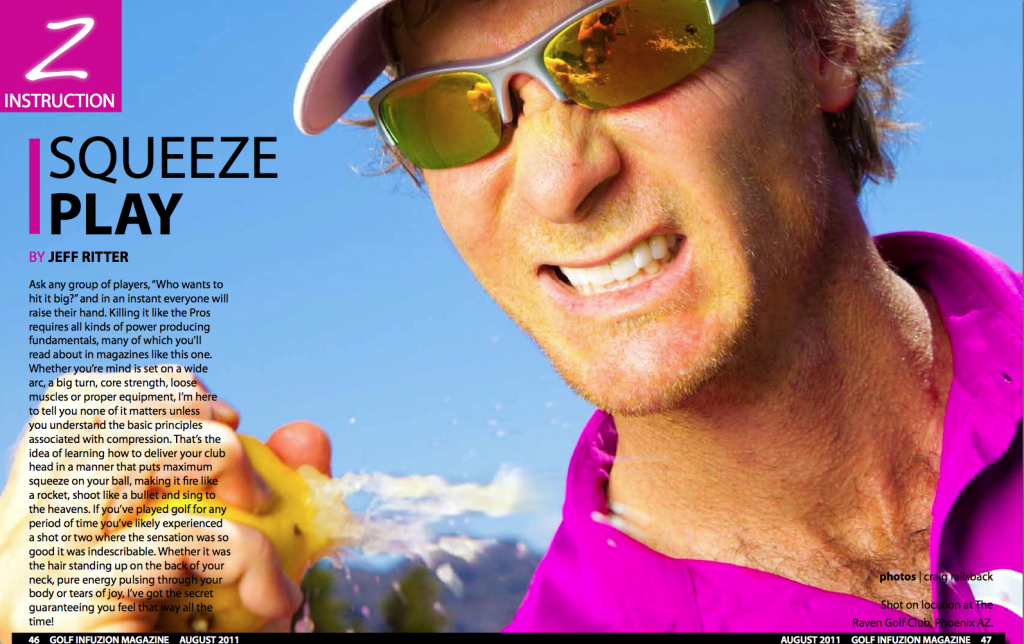
Ask any group of players, “Who wants to hit it big?” and in an instant everyone will raise their hand. Killing it like the Pros requires all kinds of power producing fundamentals, many of which you’ll read about in magazines like this one. Whether you’re mind is set on a wide arc, a big turn, core strength, loose muscles or proper equipment, I’m here to tell you none of it matters unless you understand the basic principles associated with compression. That’s the idea of learning how to deliver your club head in a manner that puts maximum squeeze on your ball, making it fire like a rocket, shoot like a bullet and sing to the heavens. If you’ve played golf for any period of time you’ve likely experienced a shot or two where the sensation was so good it was indescribable. Whether it was the hair standing up on the back of your neck, pure energy pulsing through your body or tears of joy, I’ve got the secret guaranteeing you feel that way all the time!
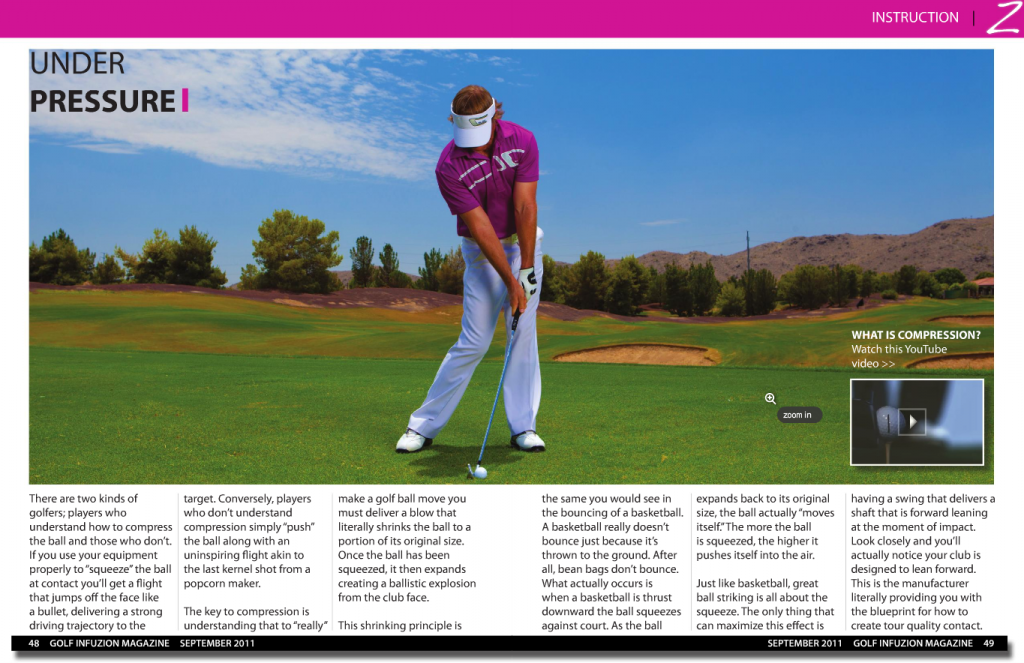
Under Pressure
There are two kinds of golfers; players who understand how to compress the ball and those who don’t. If you use your equipment properly to “squeeze” the ball at contact you’ll get a flight that jumps off the face like a bullet, delivering a strong driving trajectory to the target. Conversely, players who don’t understand compression simply “push” the ball along with an uninspiring flight akin to the last kernel shot from a popcorn maker.
The key to compression is understanding that to “really” make a golf ball move you must deliver a blow that literally shrinks the ball to a portion of its original size. Once the ball has been squeezed, it then expands creating a ballistic explosion from the club face.
This shrinking principle is the same you would see in the bouncing of a basketball. A basketball really doesn’t bounce just because it’s thrown to the ground. After all, bean bags don’t bounce. What actually occurs is when a basketball is thrust downward the ball squeezes against court. As the ball expands back to its original size, the ball actually “moves itself.” The more the ball is squeezed, the higher it pushes itself into the air.
Just like basketball, great ball striking is all about the squeeze. The only thing that can maximize this effect is having a swing that delivers a shaft that is forward leaning at the moment of impact. Look closely and you’ll actually notice your club is designed to lean forward. This is the manufacturer literally providing you with the blueprint for how to create tour quality contact.
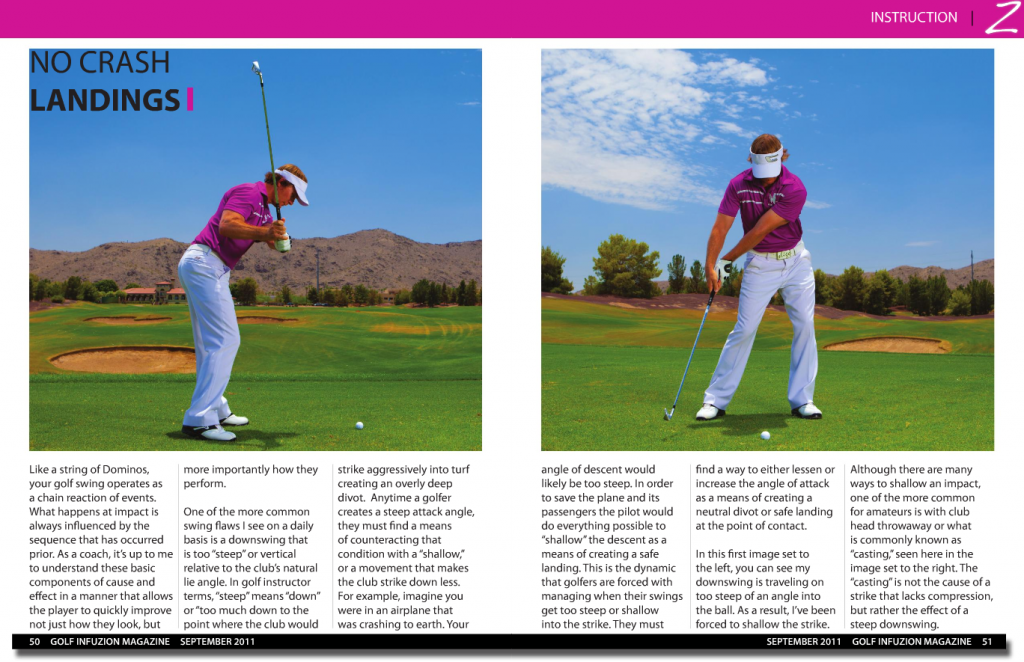
No Crash Landings
Like a string of Dominos, your golf swing operates as a chain reaction of events. What happens at impact is always influenced by the sequence that has occurred prior. As a coach, it’s up to me to understand these basic components of cause and effect in a manner that allows the player to quickly improve not just how they look, but more importantly how they perform.
One of the more common swing flaws I see on a daily basis is a downswing that is too “steep” or vertical relative to the club’s natural lie angle. In golf instructor terms, “steep” means “down” or “ too much down to the point where the club would strike aggressively into turf creating an overly deep divot. Anytime a golfer creates a steep attack angle, they must find a means of counteracting that condition with a “shallow,” or a movement that makes the club strike down less. For example, imagine you were in an airplane that was crashing to earth. Your angle of descent would likely be too steep. In order to save the plane and its passengers the pilot would do everything possible to “shallow” the descent as a means of creating a safe landing. This is the dynamic that golfers are forced with managing when their swings get too steep or shallow into the strike. They must find a way to either lessen or increase the angle of attack as a means of creating a neutral divot or safe landing at the point of contact.
In this first image set to the left, you can see my downswing is traveling on too steep of an angle into the ball. As a result, I’ve been forced to shallow the strike. Although there are many ways to shallow an impact, one of the more common for amateurs is with club head throwaway or what is commonly known as “casting,” seen here in the image set to the right. The “casting” is not the cause of a strike that lacks compression, but rather the effect of a steep downswing.
Conversely, look at the third image in this story. This shaft is approaching on a more shallow angle of attack which would produce more of a sweeping strike. Once the club is in this condition, we have the opportunity to steepen the hit. This can come in the form of a narrower release angle which is an integral component of compression. Look at players who play on shallower swinging angles such as Ben Hogan, Sergio Garcia and Chad Campbell and you’ll often see a corresponding release angle that is narrower and held much longer into the hit. Here the player’s ability to generate “lag” is not the cause of maximum compression, but the result of the swing shape they have chosen to employ.
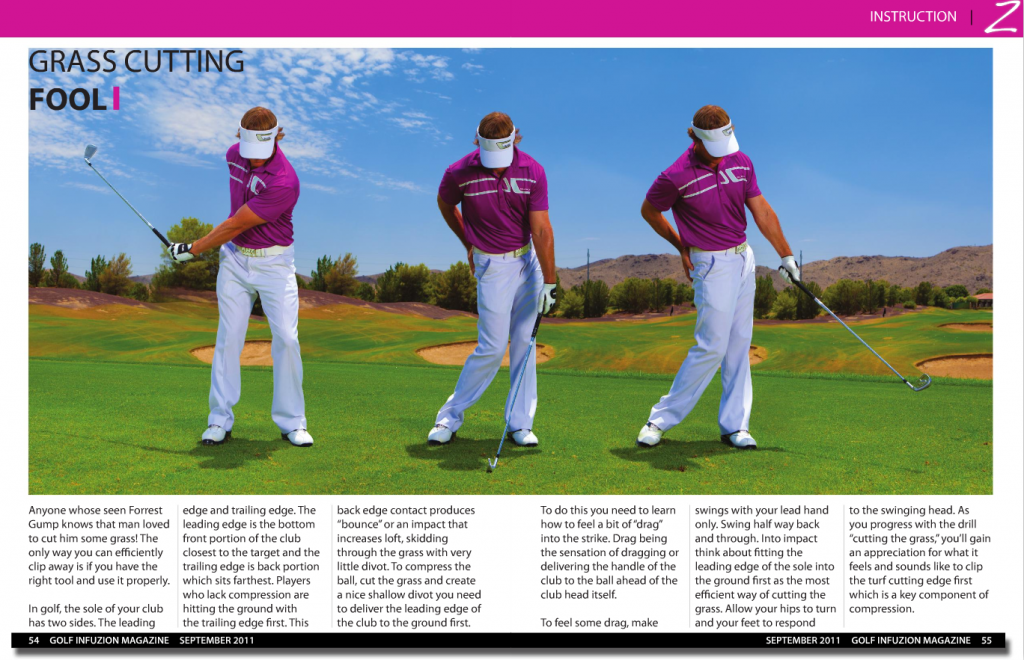
Grass Cutting Fool
Anyone whose seen Forrest Gump knows that man loved to cut him some grass! The only way you can efficiently clip away is if you have the right tool and use it properly.
In golf, the sole of your club has two sides. The leading edge and trailing edge. The leading edge is the bottom front portion of the club closest to the target and the trailing edge is back portion which sits farthest. Players who lack compression are hitting the the ground with the trailing edge first. This back edge contact produces “bounce” or an impact that increases loft, skidding through the grass with very little divot. To compress the ball, cut the grass and create a nice shallow divot you need to deliver the leading edge of the club to the ground first. To do this you need to learn how to feel a bit of “drag” into the strike. Drag being the sensation of dragging or delivering the handle of the club to the ball ahead of the club head itself.
To feel some drag, make swings with your lead hand only. Swing half way back and through. Into impact think about fitting the leading edge of the sole into the ground first as the most efficient way of cutting the grass. Allow your hips to turn and your feet to respond to the swinging head. As you progress with the drill “cutting the grass,” you’ll gain an appreciation for what it feels and sounds like to clip the turf cutting edge first which is a key component of compression.
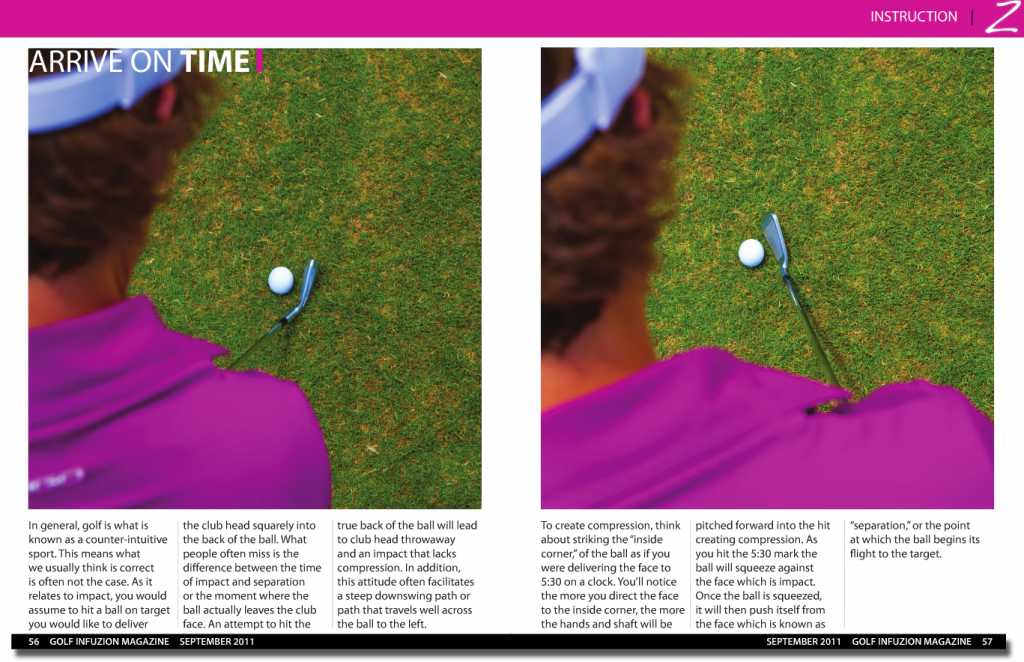
Arrive On Time
In general, golf is what is known as a counter-intuitive sport. This means what we usually think is correct is often not the case. As it relates to impact, you would assume to hit a ball on target you would like to deliver the club head squarely into the back of the ball. What people often miss is the difference between the time of impact and separation or the moment where the ball actually leaves the club face. An attempt to hit the true back of the ball will lead to club head throwaway and an impact that lacks compression. In addition, this attitude often facilitates a steep downswing path or path that travels well across the ball to the left.
To create compression, think about striking the “inside corner,” of the ball as if you were delivering the face to 5:30 on a clock. You’ll notice the more you direct the face to the inside corner, the more the hands and shaft will be pitched forward into the hit creating compression. As you hit the 5:30 mark the ball will squeeze against the face which is impact. Once the ball is squeezed, it will then push itself from the face which is known as “separation,” or the point at which the ball begins its flight to the target.
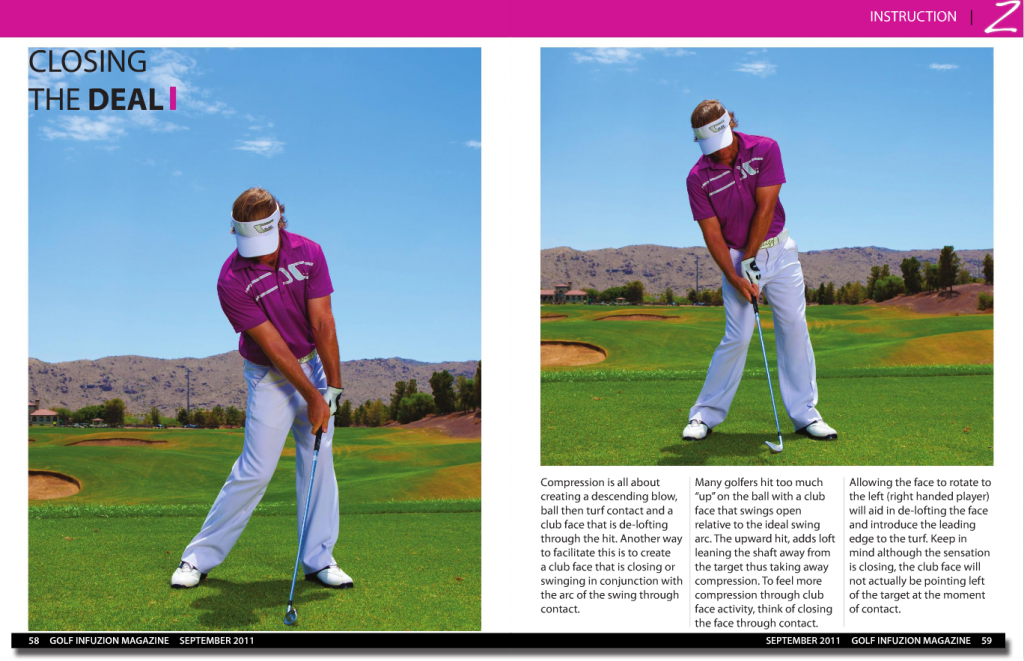
Close The Deal
Compression is all about creating a descending blow, ball then turf contact and a club face that is de-lofting through the hit. Another way to facilitate this is to create a club face that is closing or swinging in conjunction with the arc of the swing through contact.
Many golfers hit too much “up” on the ball with a club face that swings open relative to the ideal swing arc. The upward hit, adds loft leaning the shaft away from the target thus taking away compression. To feel more compression through club face activity, think of closing the face a bit through contact. Allowing the face to rotate to the left (right handed player) will aid in de-lofting the face and introduce the leading edge to the turf. Keep in mind although the sensation is closing, the club face will not actually be pointing left of the target at the moment of contact.
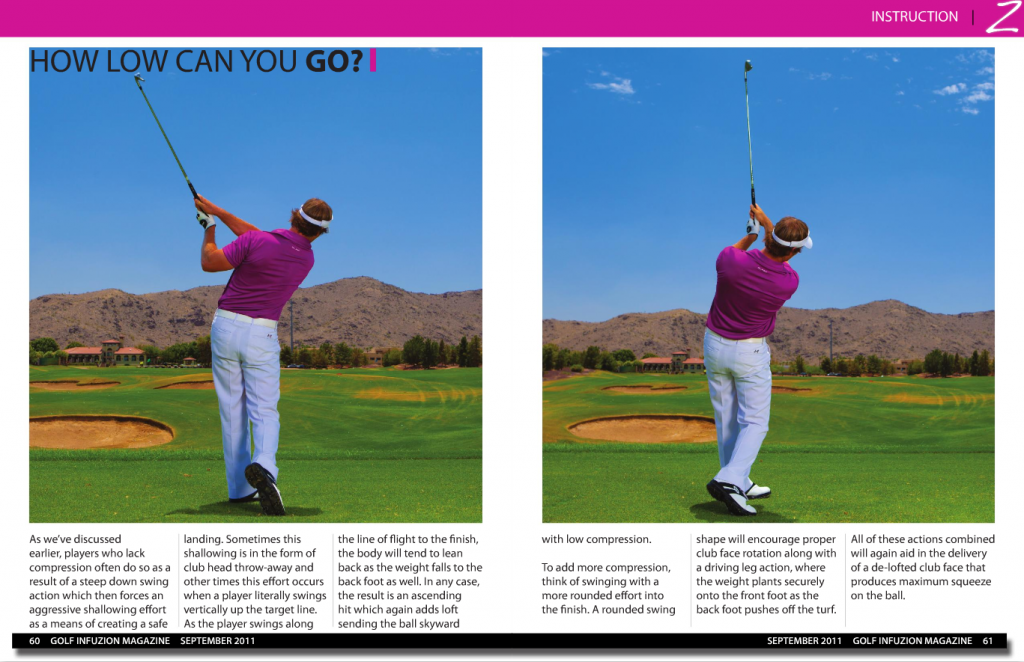
How Low Can You Go?
As we’ve discussed earlier, players who lack compression often do so as a result of a steep down swing action which then forces an aggressive shallowing effort as a means of creating a safe landing. Sometimes this shallowing is in the form of club head throw-away and other times this effort occurs when a player literally swings vertically up the target line. As the player swings along the line of flight to the finish, the body will tend to lean back as the weight falls to the back foot as well. In any case, the result is an ascending hit which again adds loft sending the ball skyward with low compression.
To add more compression, think of swinging with a more rounded effort into the finish. A rounded swing shape will encourage proper club face rotation along with a driving leg action, where the weight plants securely onto the front foot as the back foot pushes off the turf. All of these actions combined will again aid in the delivery of a de-lofted club face that produces maximum squeeze on the ball.
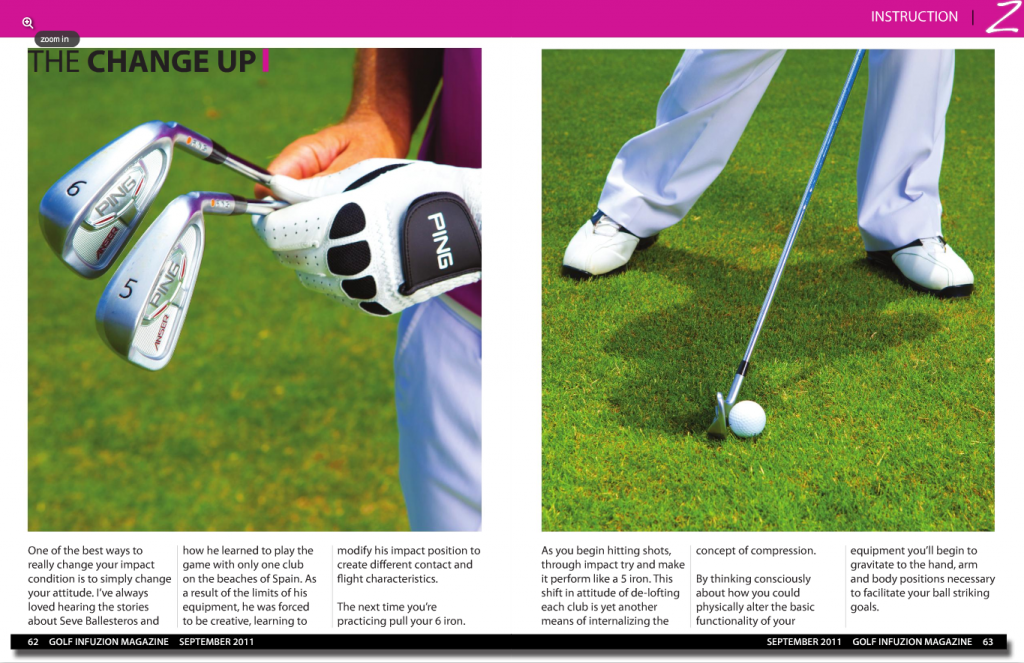
The Change Up
One of the best ways to really change your impact condition is to simply change your attitude. I’ve always loved hearing the stories about Seve Ballesteros and how he learned to play the game with only one club on the beaches of Spain. As a result of the limits of his equipment, he was forced to be creative, learning to modify his impact position to create different contact and flight characteristics.
The next time you’re practicing pull your 6 iron. As you begin hitting shots, through impact try and make it perform like a 5 iron. This shift in attitude of de-lofting each club is yet another means of internalizing the concept of compression.
By thinking consciously about how you could physically alter the basic functionality of your equipment you’ll begin to gravitate to the hand, arm and body positions necessary to facilitate your ball striking goals.
To Learn more about JRG and “Make The Turn” Click Here!
Originally seen in Golf Infuzion Magazine.








